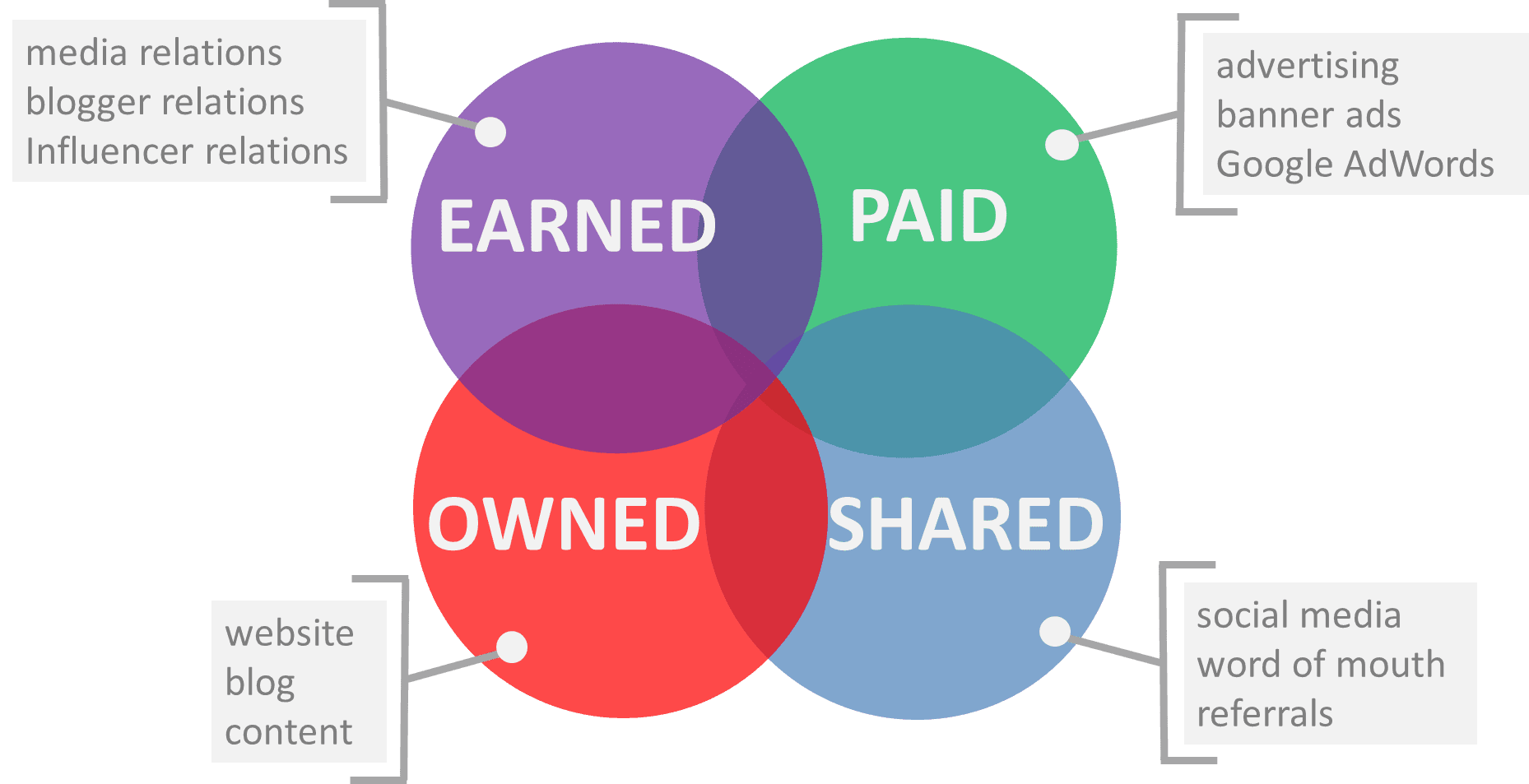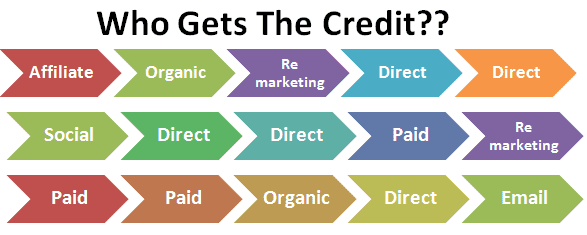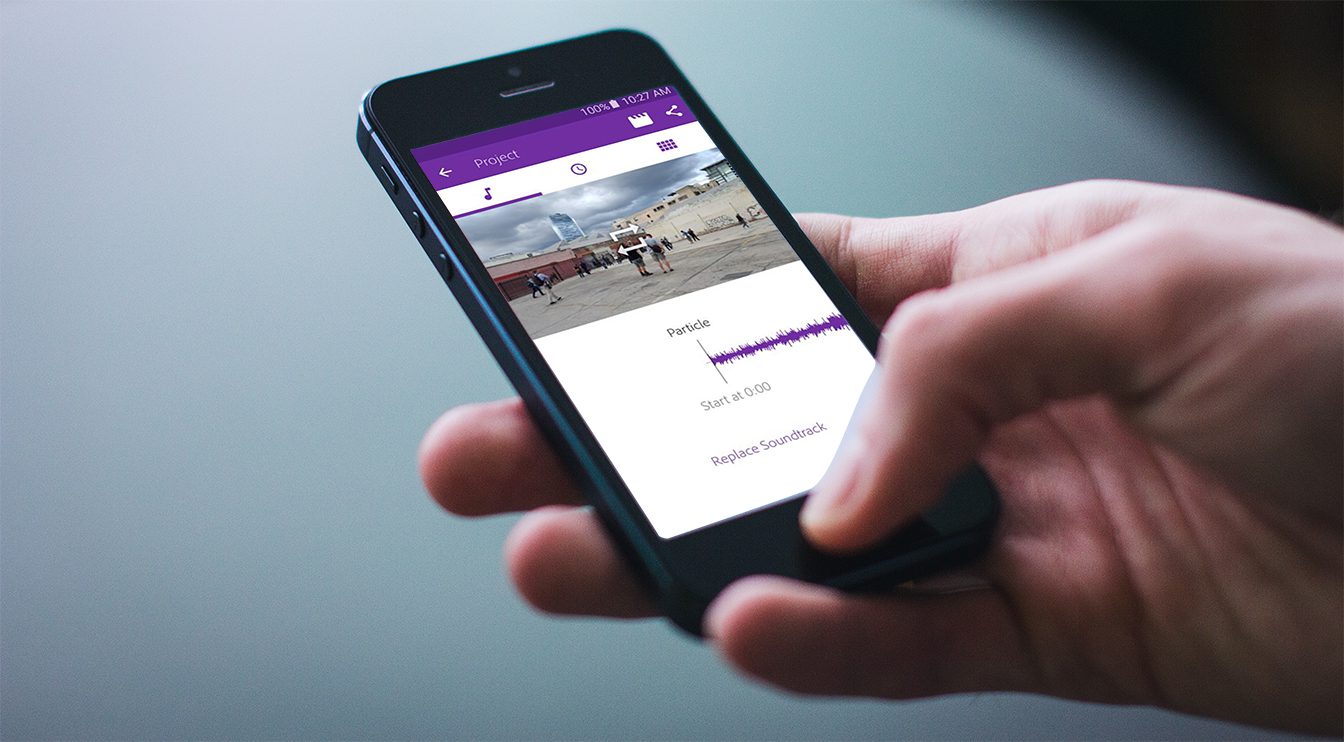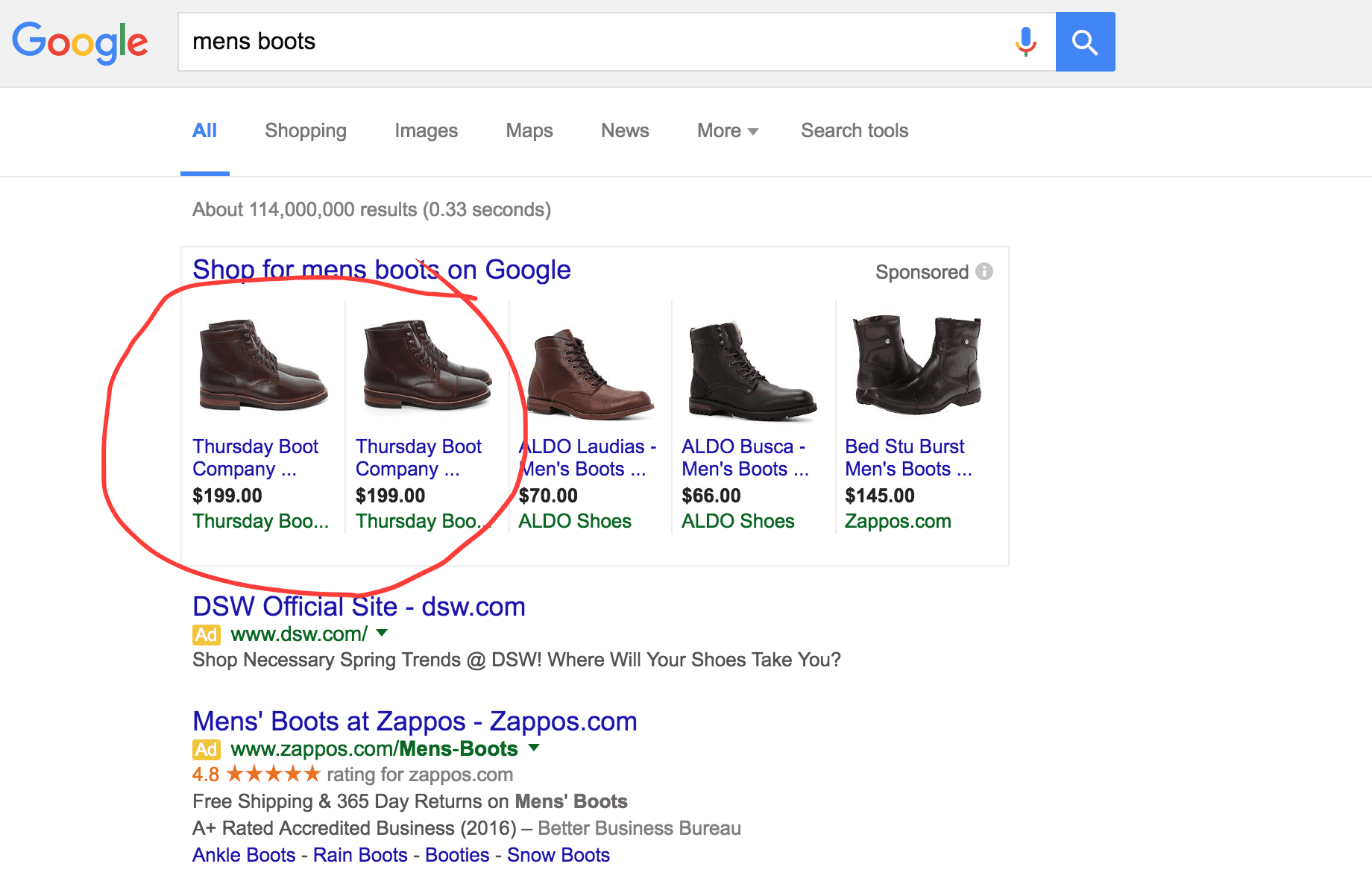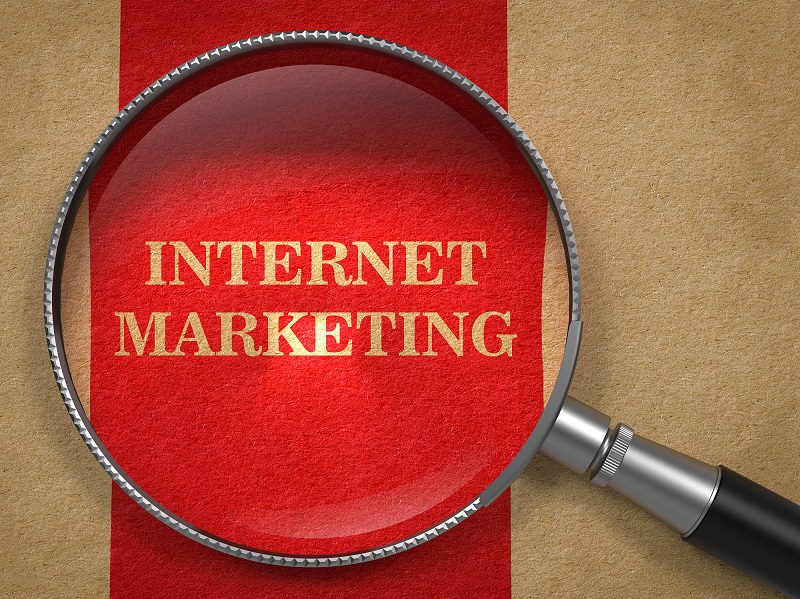For the first post of 2014, we’re going to ring in the New Year with a fresher way to think about your online marketing efforts. Prior to now, we focused heavily on the traditional 3-phased approach: Awareness (SEO, PPC), Consideration (Social Media, Email Newsletters/Drips, Downloadables), and Purchase (Retargeting), and for some of you, we added a 4th component called Retention — the things we do post-sale to ensure we get the maximum LTV out of the customer. But for 2014, our businesses need to get a little more advanced in thinking about how our potential customers not only find us, but also engage with us, either directly or indirectly. If our online marketing is going to work as effectively and efficiently as possible, we can’t just have “one horse” in the race anymore — like just doing an SEO campaign, but ignoring everything else. This is where Paid, Owned, Earned and Shared Media come in, making your online marketing campaign much more well-rounded and better suited for lead generation in the much earlier phases of the marketing and sales funnels.
According to research done by Forrester, during nearly two-thirds of the buying cycle (early research phase), your prospects are using online search, talking to peers and reading what the experts have to say to form their opinion of you before they attempt to call you and generate a lead for your sales team. Peter O’Neill refers to this as the “Customer Decision Journey” — and yes, this is primarily for you B2B folks.
Paid Media: This is media you pay for, like Google AdWords or other types of search or display advertising. This segment should be extremely well thought-out, so your landing pages can serve for PPC and SEO purposes. They need to have clear calls-to-action, and the use of keywords and content needs to address the problems or solutions your potential customer is looking for.
Owned Media: This is the content that your business creates, like this blog, or the free download you can get from the banner in the sidebar. It’s where you spend your money in SEO. B2B marketers invest over $16 billion per year in creating content designed primarily to produce leads, according to Donovan Neale-May, executive director of the CMO Council. He adds “Too many [marketers] are failing buyers with overly promotional and overly technical content that doesn’t adequately address market challenges and customer needs. B2B buyers are looking for content that’s original, consultative, and highly pertinent to where they are in their decision-making process.”
Earned Media: This is where the customer becomes the channel. Big influencers here are word of mouth (WOM), reviews and ratings, press releases or any buzz or “viral” content. For example, in 2009 Pear did a study on the use of Twitter, and within 48 hours, it was the most trending topic on Twitter and was carried in news outlets all over the world. While many businesses, particularly B2B, rely on WOM as a primary driver for leads, it’s really only one small factor.
Shared Media: This is largely influenced by social media activity. Are you following and sharing the content of the primary influencers in your category, and are they sharing your content? Are you engaged in LinkedIn groups or other verticals that are related to your category? Even if you only have 400 people following you, those 400 people have followers, and so on. So your “network” could potentially reach thousands of people that could click on or download your content.
The question remains: what percentage of each of these should make up our “ideal marketing mix”? Honestly, that’s going to depend on your industry, your budget and many other factors. Luckily, Pear’s services span all 4 of these categories. Let’s go through a sample B2B marketing mix, complete with budgets and predictions.
Sample B2B Online Marketing Plan that includes Paid, Owned, Earned and Shared Media
Assumptions:
First, let’s draw up some assumptions for the ACME Co., a B2B company specializing in big data management.
1. Current revenue is $10 million, goal revenue is $15 million, and an average sale is $250,000
2. Current traffic to site is about 5,000 visits per month
3. Current visitor-to-lead conversion rate is 0.5%, and lead-to-sale conversion rate is 20%
So in order for ACME to gain $5 million in new sales, they will need 20 new customers who pay their average fee of $250,000. How are we going to find 20 new customers? The VP of ACME insists that none of his current leads in the pipeline came from a Google search. However, as Peter O’Neill points out (from the link referenced above):
“What is important about the buyers’ discovery phase is that they definitely do not type “ERP” into a search engine. They look for information (via search, communities, discussion forums, websites, blogs) that is based upon their business issues and outcomes. So the most critical need for B2B marketers to understand is that their awareness/discovery content must be in the language of the buyer; it must answer the immediate question being posed and not more (certainly no selling or even gatekeeping contact data gathering); and it should accelerate the buyer along their journey. This is a major challenge for most B2B marketers – they are great at creating content about themselves or their offering but not at creating “outside-in” content.”
Strategy:
What we’re going to need to do is think through a strategy that includes (but is not limited to):
1. Identifying the influencers in your space – who is the one person, or group of people your buyers will turn to for suggestions or answers? What Twitter handles or LinkedIn groups are actively influencing your target market? Who has a higher Klout score or an active Google+ page? Perhaps ACME needs to be listed on the Gartner Magic Quadrant Report, since many of the CIOs in their space turn there to discover the industry leaders.
2. Identify the problems that your would-be customers are facing on a daily basis. As O’Neill point out, they won’t be doing a Google search for “ERP,” but perhaps “how can I get an executive dashboard” or “I need all of my company data in one place.” This may involve getting some feedback from the sales team about the questions asked most frequently on sales demos or pre-sales calls.
3. What are some search phrases in the space that are being used frequently – perhaps even jargon or acronyms? By using Google’s search tools we can uncover data from world-wide searches and perhaps even pinpoint some geo-locations where the terms are searched more often. We can use that to geo-target a PPC campaign or even run a direct mailer to those areas.
4. What are my primary competitors doing for search? What keywords are they targeting or bidding on? What kind of content are they promoting on their website? Are they retargeting me? All of these questions and many more can be answered, giving you a very good idea of the competitive landscape in order to see opportunities that may be wide open.
5. What newsworthy things is the company doing or engaged in that could be used in a series of planned press releases? Perhaps the acquisition of another company, the launch of a new product, or the opening of a new office or new market.
6. What content do we need to develop to support #2 and #3? What should be segmented into blogs, how-to’s, infographics, whitepapers and eBooks? Should we have a Resources section on our website? Do we need video content (since YouTube is the 2nd largest search engine, and 60%+ of the content is corporate). Develop a content calendar and strategy where you can build up your owned media and influence shared media.
Marketing Mix:
So to determine the proper marketing mix, I’ll use our PearPrediction™ modeling tool to help decide what level of service we’ll need to generate a sufficient amount of lead flow to get to the 20 new customers. Keep in mind that to simplify this model, I’m not taking into consideration things like sales cycle time, or billing arrangements, etc.
Paid Media – Our research shows that the average CPC on many of the industry words is about $10 per click. I like to get at least 30 clicks per day to give me enough data to make campaign decisions that are statistically significant. So ACME would be looking at about $9,000 in clicks and $840/month in management – and that’s just for Google AdWords. Expand into Bing, Yahoo, retargeting and other vertical display options, and the price could go up to $20,000 per month pretty quickly. But let’s say we’ll put this at $10,000 at the low end, and $20,000 at the high end.
Owned Media – Here we want to build up the “corporate content” quite significantly and address strategies #2, 3 and 6. We want to be careful as to not make the corporate content too biased or technical. Our Pro SEO plan will address things like blog content writing and beefing up existing page content for products or services (among other things), but additional budget will be needed for things like whitepapers, eBooks and infographics. You want all of your pieces well designed with both digital and print versions. Don’t skimp on the design – it matters! Our Pro plan is $2,520, but I would budget an additional $5,000 per month for the creation of these other pieces.
Earned Media – You may already have a PR firm working on your account, but if you don’t, Pear can work in one press release per month included already with your Pro SEO plan. We’ll write the release and syndicate it through our MarketWire account. The result could be hundreds of additional links pointing to your website (great for SEO), as well as some inquiries. This channel may also take some creative thinking about some of the potential viral content you may able to produce – either written or video. Any poor ratings or reviews of your business will need to be addressed as well, and may require some additional monitoring. I’ll put this one at $5,000 per month, in case you already have a PR firm on retainer.
Shared Media – We will need a team of folks monitoring the social networks, LinkedIn Groups, forums, other blogs, etc. not only to see what the customer sentiment is for your industry, but also to keep a lookout for opportunities to engage in conversation, share a post or whitepaper, address a problem with potential solutions, and syndicate your content through these channels to make your brand more visible. You might already have a social media company for this, but if you don’t, Pear includes some of the social syndication as part of your Pro SEO plan. I would budget an additional $1,500+ for the monitoring and engagement pieces. Let’s put this piece at $3,000 per month if you have already retained a social media company.
So the total dollars allocated for this marketing mix is:
Paid Media: $10,000-20,000 per month
Owned Media: $7,500 per month
Earned Media: $5,000 per month
Shared Media: $3,000 per month
Total: $25,500-$35,500 per month, or $306,000-$426,000 per year.
Sound like a lot? Let’s consider that your business should be putting about 2-4% of your gross revenue towards marketing, so in the case of ACME, I would argue that they should be spending about $400,000 per year, excluding any marketing staff salaries or overhead. That said, I think we’re in line with that, and they could conceivably lower their paid media spend and make room for things like Advanced Analytics or Conversion Testing, where we analyze data to determine how to increase conversion rates through the funnel.
OK, so ACME says they would approve the $400,000 budget, but they want to know what they can expect. Here’s where the PearPredictionTM tool comes in. It allows us to see what kind of traffic flow and lead flow we can expect, given the assumptions made on what the campaign could produce over time. Keep in mind that if your company doesn’t know things like conversion rate, or lifetime value of the customer, the level of confidence for the prediction goes down. Actual numbers are helpful in building a more accurate model.
Paid Media: Spending $10,000 per month on paid should result in 1,000 new visits to the site or landing page that was set up. At a 0.5% conversion rate from visit to lead, we can hope to get 60 leads in a year. Let’s assume only 50% are actually qualified, so that gets us down to 30 qualified leads per year. Again, not taking into consideration the sales cycle, which could be 6+ months for you, we could assume that with our 20% lead to sale ratio, this channel could generate 6 new customers for the business, or $1,500,000.
Owned Media: Our SEO prediction suggests that we can increase the traffic flow of the website from 5,000 per month by 40-60% by the 12th month, resulting in a net increase in traffic of 2,000-3,000 more visits by the 12th month. Total increase over 12 months is about 16,000 visits. That equates to a new potential lead flow of 80 per annum, and using the same assumptions for qualified lead ratio and close ratio, this channel could generate 8 additional customers at another $2,000,000.
For Earned and Shared media, it will be difficult in some instances to attribute any leads, or soft conversions to things like social media and PR. For this reason, we utilize the Multi Channel Funnel option in Google Analytics to give us a better sense of how these channels may be assisting in conversions down-path. Some of these will have a direct impact on lead generation, such as press releases, and some social activity can be tracked and directly attributed. But overall, if this sample campaign is executed and performs as expected, and the assumptions hold true, then the $400,000 investment could yield the company nearly $4 million in sales, giving them a 10X return on investment for the campaign.
Conclusion:
Every business and every campaign will need a multi-faceted strategy including paid, owned, earned and shared media, regardless of your size or budget for 2014. If you don’t have the budget and goals of ACME, then start small, but have a strategy for all of the channels. The “one-trick pony” of running just an SEO or PPC campaign on their own may not get you to the goals you set. Don’t try to just “dip your toe” in and expect dramatic results in 90 or 120 days. There will be lots of trial and error to see what generates the best results, so stick with it and good luck!


